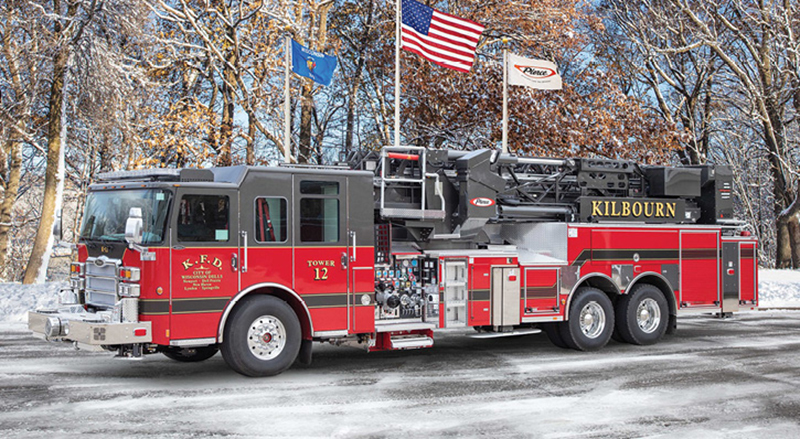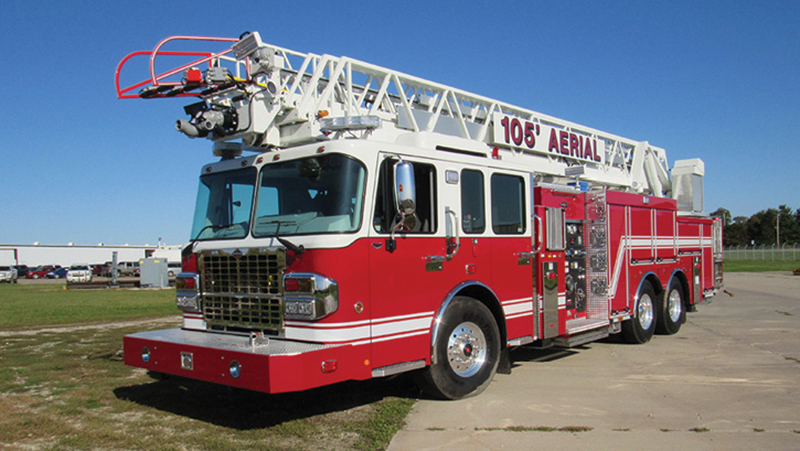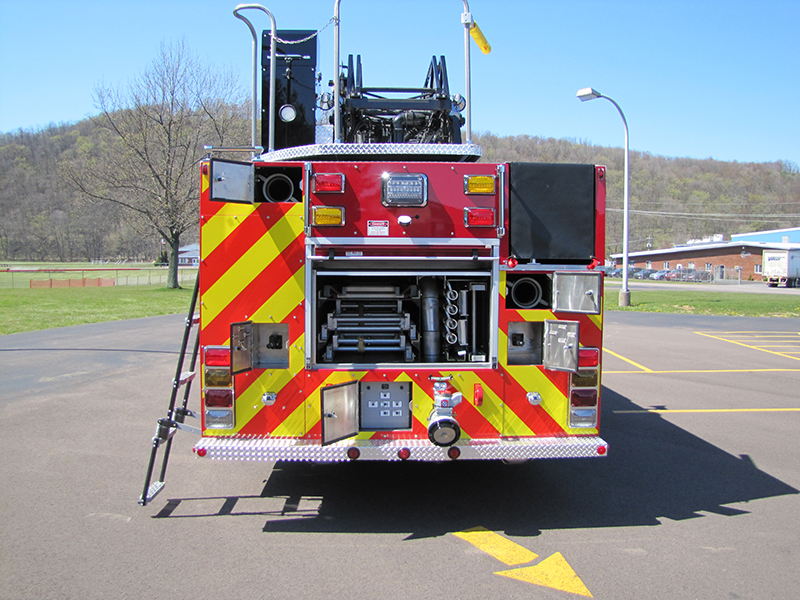Quints—those trucks with an aerial device, pump, water tank, ground ladder complement, and hosebed for supply lines—seemingly have become the most popular truck company vehicle across the country, according to aerial vehicle manufacturers.
They say such rigs outnumber straight trucks (no pump or water tank) on their production lines.
Justin Rice, aerial sales manager for E-ONE, points out that E-ONE has been building many more quints than straight trucks in recent years. “There are definitely more quints being built than straight trucks with no pump or tank,” Rice says. “While we have been building straight trucks for cities like Memphis, Tennessee; Phoenix, Arizona; Boston, Massachusetts; Cincinnati, Ohio; and Chicago, Illinois, we still build a lot more quints, especially for those departments that are asking for big water and larger complements of ground ladders.”
Rice says that E-ONE has been building quints for Orange County (FL) Fire Rescue for quite some time and most recently building quints for them using the clean cab concept. “For Escambia County (FL) Fire Rescue, we built a Metro 100 aerial ladder quint with a 1,500-gallon-per-minute (gpm) pump, a 300-gallon water tank, a single-lay SideStacker® hosebed, and 89 feet of ground ladders in an enclosed tunnel,” he notes.

1 E-ONE built this Metro 100 aerial ladder quint for Escambia County (FL) Fire Rescue with a 1,500-gpm pump, a 300-gallon water tank, a single-lay SideStacker® hosebed, and 89 feet of ground ladders in an enclosed tunnel. (Photo 1 courtesy of E-ONE.)

2 Pierce Manufacturing Inc. built this 100-foot Ascendant aerial tower quint with a Waterous 2,000-gpm pump, a 300-gallon foam tank, a 20-gallon foam tank, and a Husky™ 3 foam system for the Kilbourn (WI) Volunteer Fire Department. (Photo 2 courtesy of Pierce Manufacturing Inc.)
Dave McAlice, northeast regional vice president for Pierce Manufacturing Inc., agrees that quints are very popular around the country. “On a national scale, 85% of the trucks Pierce builds are quints,” McAlice observes. “Even in the Northeast, where straight trucks are the former norm, we are seeing about 60 to 70% of the trucks we are building are quints.”

3 KME built this 101-foot tractor drawn aerial (TDA) quint for the San Bernardino County (CA) Fire Department. (Photo 3 courtesy of KME.)

4 This SLR 75 aerial ladder quint built by Sutphen Corp. for the Atoka (TN) Fire Department has a Hale Qmax 1,500-gpm pump, a 500-gallon water tank, and a 20-gallon foam tank. (Photo 4 courtesy of Sutphen Corp.)
McAlice notes that many of the younger members of truck committees are choosing quints with big water tanks, lots of ground ladders, and a large complement of hose. “On our 107-foot Ascendant aerial quint, we’ll usually see a pump from 1,500 to 2,000-gpm, a water tank of up to 400 gallons, and a hose load of 800 to 1,000 feet of 5-inch large-diameter hose (LDH),” he says. “In terms of ground ladders, a department has to prioritize. If they’re pulling ground ladders a lot for two-story structures, they often go with two-section extension ladders and long roof ladders. For a three-decker structure, they usually have a 28-foot two-section extension ladder to hit the third floor or a 35-foot three-section extension ladder to hit the roof.”
Tim Besser, sales manager for KME, points out that three quarters of KME’s aerials on the production line have pumps and tanks on them, while two fifths of the KME tractor-drawn aerials (TDAs) have pumps and tanks. “Seventy-four percent of the trucks in the KME backlog have pumps and tanks on them and the other elements of quints, and 38% of our TDAs have pumps, tanks, and hose loads, making them quints, which some people call ‘quillers,’ ” Besser says.
The advantages of a quint, Besser notes, “Is it’s the fire truck that can do everything. Some departments run their quint as first out and then back the truck up with a tanker or pumper-tanker. Doing so gives them a lot of flexibility in long, narrow driveways where you only have room to fit one vehicle.” But Besser sees a disadvantage to running a quint as first due. “On the negative side, you’re asking the quint crew to do a lot of work with a minimum number of people and also to determine whether to set up the rig for truck operations or for an engine hoseline attack.”
Besser says that pump sizes on quints typically run a minimum of 1,500 gpm and that hose loads also vary. “We have a couple of different hose configurations for quints, with one holding 500 to 600 feet of 5-inch LDH on a truck with high side compartments to up to 1,000 feet of LDH by adjusting the height of those compartments,” he says. “We are experiencing about 50-50 in the two types of hose loads on quints.”
Zach Rudy, director of sales for Sutphen Corp., says most of Sutphen’s aerials are set up as quints. “We don’t make a lot of pumpless and tankless aerials like those in big metro areas,” he says. “Outside of the big cities, most fire departments run quints, although some departments, like the city of Columbus, Ohio, want to carry a larger complement of ladders on their truck, so they have a pump but no water tank.”
Rudy points out that both Sutphen’s SPH 100-foot aerial platform quint and its SL 100 aerial ladder quint can handle a 1,500- to 2,000-gpm pump, up to a 500-gallon water tank, full-size compartments, and 900 feet of 5-inch LDH in a low-hosebed configuration. He adds that Sutphen’s SL 75 quint can take the same size pumps, 500 gallons of water, and accommodate a full ground ladder complement and 600 to 800 feet of LDH in a low hosebed.
Robert Triche, regional sales manager for Ferrara Fire Apparatus, points out that Ferrara always has been more of a quint manufacturer as opposed to a maker of trucks with no pump or tank. “It’s not a new shift for us because quints have always been our bread and butter,” Triche says. “The go-to pump on our quints usually is a Hale Qmax 2,000-gpm pump, and we can put up to a 400-gallon tank on the rig, but normally it’s a 250-gallon or 300-gallon water tank.”

5 Ferrara Fire Apparatus built this 107-foot aerial ladder quint with a 2,000-gpm Hale Qmax pump, a 630-gallon water tank, and a 20-gallon foam tank for the South Montgomery County (TX) Fire Department. (Photo 5 courtesy of Ferrara Fire Apparatus.)

6 Spartan ER built this 105-foot aerial ladder quint for the Wadesboro (NC) Fire Department on a Spartan Gladiator chassis with a Hale Qmax 2,000-gpm pump, a 400-gallon water tank, and a 20-gallon foam cell. (Photo 6 courtesy of Spartan ER.)

7 4 Guys Fire Trucks built this 60-foot aerial ladder quint for the Bristol (TN) Fire Department with a 2,000-gpm Waterous pump, a 300-gallon water tank, and a 102-foot ground ladder complement. (Photo 7 courtesy of 4 Guys Fire Trucks.)
Triche notes that long straight-stick quints are gaining in popularity, especially in suburban and highly residential communities. “Our 107-foot straight-stick aerial is becoming more popular, especially for those fire departments that have a lot of houses with big setbacks,” he says. “With the 107-foot aerial, we are able to hit the peak of a roof on a set-back house, something that’s not possible with most shorter aerials. We also are finding that departments want their quints to carry as much of a complement of pumper equipment as possible, because they want the rig to serve as a first due if necessary.”
Chris Wade, director of sales for Spartan ER, says his company continues to see quints as being the most popular type of aerial among fire departments. “Quints are very popular, and in fact, 95% of our rear-mount aerials are quints,” Wade points out. “Tillers are a little bit different in the percentages, but they also are strong on the quint side.”
Wade says Spartan ER recently built a 75-foot rear-mount aerial quint for the Mason (MI) Fire Department on a Spartan Metro Star chassis with a Waterous CXSC20 1,500-gpm pump, a 500-gallon water tank, and a 105-foot aerial ladder quint for Wadesboro (NC) Fire on a Spartan Gladiator chassis with a Hale Qmax 2,000-gpm pump, a 400-gallon water tank, and a 20-gallon foam cell.
Nate Callahan, mechanical engineer for 4 Guys Fire Trucks, believes that quints are popular around the country because of their pricing. “A quint combines an engine and an aerial in a single vehicle,” Callahan says, “and while a quint may cost more than either an engine or a straight truck, it saves a department money by not having to buy two rigs.” Callahan adds that the department also only has maintenance and insurance costs for a single rig with a quint, as opposed to two vehicles.
Callahan says that departmental consideration on the length of the aerial ladder and hosebed capacity will dictate whether the vehicle will be a single- or tandem-rear-axle quint. “If they want a midmount ladder and midship pump, you have to look at a three- or four-section ladder to keep the body shorter,” he notes. “If they go with a rear-mount aerial, then they will be able to use longer aerial ladder sections on a longer body.”
ALAN M. PETRILLO is a Tucson, Arizona-based journalist, the author of three novels and five nonfiction books, and a member of the Fire Apparatus & Emergency Equipment Editorial Advisory Board. He served 22 years with the Verdoy (NY) Fire Department, including in the position of chief.

